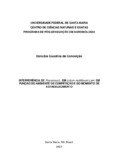| dc.creator | Conceição, Danúbia Quadros da | |
| dc.date.accessioned | 2021-11-03T14:16:09Z | |
| dc.date.available | 2021-11-03T14:16:09Z | |
| dc.date.issued | 2021-06-22 | |
| dc.identifier.uri | http://repositorio.ufsm.br/handle/1/22674 | |
| dc.description.abstract | The species Poa annua, of the poaceae family, has been shown to occur in pasture
environments in the state of Rio Grande do Sul. There is a great presence of this species as
a weed during the winter period, occupying an extensive area of pastures, competing with
ryegrass forage, for example. The objective was to evaluate the interference of Poa annua in
different populations and conditions of competition with a single ryegrass plant. Two
experiments were carried out in a completely randomized design with five replications in a
3x5 factorial scheme, testing different competition strata (aerial part, root system, and aerial
part and root system) and ryegrass establishment times (together or after the competing
species), with growing populations of Poa annua (0, 35, 139, 279, 419 plants m-2). The
variables analyzed 50 days after the start of the competition were plant height, length of the
root system, stem diameter, and green mass of the aerial part and ryegrass root system. The
variables were subjected to analysis of variance, normality (Shapiro-Wilk) and homogeneity
(O’Neill-Matthews). The levels of factor A were differentiated by calculating the confidence
interval of the averages and in factor B the complementary analysis was by quadratic
regression. In the first experiment, interaction between factors was observed for the variables
root length, stem diameter and green mass of the aerial part and root system. For the second
experiment, there was an interaction between factors for all variables. It is concluded that the
negative interference of Poa annua on ryegrass is greater when the plants compete entirely
for the resources of the environment, that is, for the aerial part and root system. There is a
detrimental effect on ryegrass growth and less competitive ability when it is established after
Poa annua. | eng |
| dc.language | por | por |
| dc.publisher | Universidade Federal de Santa Maria | por |
| dc.rights | Attribution-NonCommercial-NoDerivatives 4.0 International | * |
| dc.rights.uri | http://creativecommons.org/licenses/by-nc-nd/4.0/ | * |
| dc.subject | Pastinho de inverno | por |
| dc.subject | Lolium multiflorum | por |
| dc.subject | Estudo de vizinhança | por |
| dc.subject | Annual bluegrass | eng |
| dc.subject | Neighborhood design | eng |
| dc.title | Interferência de Poa annua L. em Lolium multiflorum Lam. em função do ambiente de competição e do momento de estabelecimento | por |
| dc.title.alternative | Interference of Poa annua L. in Lolium multiflorum Lam. as a function of the competition environment and the establishment time | eng |
| dc.type | Dissertação | por |
| dc.description.resumo | A espécie Poa annua, da família Poaceae, tem demonstrado ocorrência em
ambientes de pastagens no Estado do Rio Grande do Sul. Existe uma grande presença
dessa espécie como planta daninha durante o período de inverno ocupando, uma extensa
área das pastagens, competindo com azevém, por exemplo. Objetivou-se avaliar a
interferência de Poa annua em diferentes populações e condições de competição com uma
única planta de azévem. Foram realizados dois experimentos em delineamento inteiramente
casualizado com cinco repetições em esquema fatorial 3x5, testando diferentes estratos de
competição (parte aérea, sistema radicular, e parte aérea e sistema radicular) e épocas de
estabelecimento de azevém (junto ou depois da espécie competidora), com populações
crescentes de Poa annua (0, 35, 139, 279, 419 plantas m-2). As variáveis analisadas após 50
dias do início da competição foram estatura de plantas, comprimento do sistema radicular,
diâmetro de colmo, e massa verde da parte aérea e sistema radicular de azevém. As
variáveis foram submetidas à análise da variância, normalidade (Shapiro-Wilk) e
homogeneidade (O’Neill-Matthews). Os níveis do fator A foram diferenciados pelo cálculo do
intervalo de confiança das médias e no fator B a análise complementar foi por regressão
quadrática. No primeiro experimento observou-se interação entre os fatores para as
variáveis comprimento de raiz, diâmetro do colmo e massa verde da parte aérea e do
sistema radicular. Já para o segundo experimento, observou-se interação entre os fatores
para todas as variáveis. Conclui-se que a interferência negativa de Poa annua em azevém é
maior quando as plantas competem integralmente pelos recursos do ambiente, ou seja, pela
parte aérea e sistema radicular. Há efeito prejudicial ao crescimento de azevém e menor
habilidade competitiva quando o mesmo se estabelece após a Poa annua. | por |
| dc.contributor.advisor1 | Ulguim, André da Rosa | |
| dc.contributor.advisor1Lattes | http://lattes.cnpq.br/8885152893126479 | por |
| dc.contributor.referee1 | Zandoná, Renan Ricardo | |
| dc.contributor.referee2 | Dornelles, Sylvio Henrique Bidel | |
| dc.creator.Lattes | http://lattes.cnpq.br/7548807251187870 | por |
| dc.publisher.country | Brasil | por |
| dc.publisher.department | Ciências Biológicas | por |
| dc.publisher.initials | UFSM | por |
| dc.publisher.program | Programa de Pós-Graduação em Agrobiologia | por |
| dc.subject.cnpq | CNPQ::CIENCIAS BIOLOGICAS | por |
| dc.publisher.unidade | Centro de Ciências Naturais e Exatas | por |



